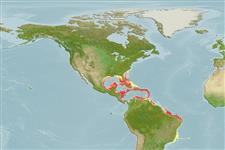Environment: milieu / climate zone / depth range / distribution range
Ecología
marino asociado a arrecife; rango de profundidad 12 - 396 m (Ref. 9710), usually 18 - 90 m (Ref. 7251). Tropical; 32°N - 7°N, 99°W - 59°W
Western Atlantic: southern Florida (USA), Bahamas, Honduras and Virgin Islands; probably widespread in Caribbean reef areas. Including Antilles (Ref. 26938).
Tamaño / Peso / Age
Maturity: Lm ? range ? - ? cm
Max length : 8.0 cm TL macho / no sexado; (Ref. 9710)
Espinas dorsales (total): 10; Radios blandos dorsales (total): 12
Found over rubble, silty or sandy bottoms (Ref. 9710). Often in small groups hovering over a patch of coral rubble or an old conch shell (Ref. 13442). Feeds on plankton (Ref. 9710). Synchronously hermaphroditic. Difficult to approach (Ref. 9710).
Life cycle and mating behavior
Madurez | Reproducción | Puesta | Huevos | Fecundidad | Larva
Pelagic spawner.
Robins, C.R. and G.C. Ray, 1986. A field guide to Atlantic coast fishes of North America. Houghton Mifflin Company, Boston, U.S.A. 354 p. (Ref. 7251)
IUCN Red List Status (Ref. 130435)
Threat to humans
Harmless
Human uses
Acuario: Comercial
Más información
ReferenciasAcuiculturaPerfil de acuiculturaRazasGenéticaElectrophoresesheritabilidadEnfermedadesProcesamientoNutrientsMass conversion
ColaboradoresImágenesStamps, Coins Misc.SonidosCiguateraVelocidadTipo de nataciónSuperficie branquialOtolitosCerebrosVisión
Herramientas
Special reports
Download XML
Fuentes de Internet
Estimates based on models
Preferred temperature (Ref.
123201): 23.3 - 28, mean 26.6 °C (based on 314 cells).
Phylogenetic diversity index (Ref.
82804): PD
50 = 0.5000 [Uniqueness, from 0.5 = low to 2.0 = high].
Bayesian length-weight: a=0.01096 (0.00514 - 0.02340), b=3.05 (2.88 - 3.22), in cm total length, based on LWR estimates for this Genus-body shape (Ref.
93245).
Nivel trófico (Ref.
69278): 3.1 ±0.2 se; based on diet studies.
Resiliencia (Ref.
120179): Alto, población duplicada en un tiempo mínimo inferior a 15 meses (Preliminary K or Fecundity.).
Fishing Vulnerability (Ref.
59153): Low vulnerability (10 of 100).
Nutrients (Ref.
124155): Calcium = 125 [64, 270] mg/100g; Iron = 1.03 [0.55, 1.93] mg/100g; Protein = 17.7 [15.7, 19.4] %; Omega3 = 0.214 [0.115, 0.396] g/100g; Selenium = 42.5 [20.3, 93.8] μg/100g; VitaminA = 191 [61, 719] μg/100g; Zinc = 1.97 [1.25, 2.94] mg/100g (wet weight);
